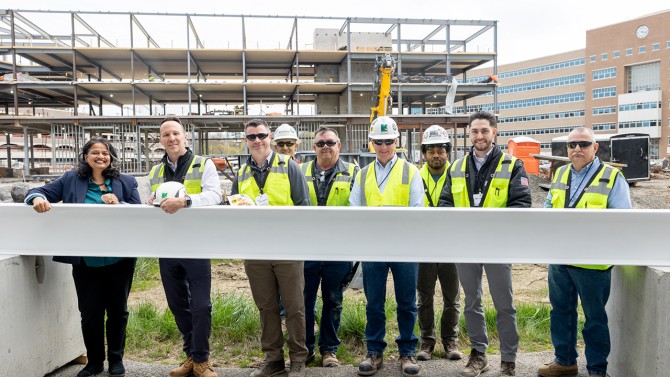The unemployment rate remained at 3.5 per cent in June (seasonally adjusted), in line with the updated figure for May, according to data released today by the Australian Bureau of Statistics (ABS).
Bjorn Jarvis, ABS head of labour statistics, said: “with employment increasing by around 33,000 people and the number of unemployed decreasing by 11,000 people, the unemployment rate remained at 3.5 per cent.
“The rise in employment in June saw the employment-to-population ratio remain at a record high 64.5 per cent, reflecting a tight labour market in which employment has recently increased in line with population growth.
“In addition to there being over a million more employed people than before the pandemic, a much higher share of the population is employed. In June 2023, 64.5 per cent of people 15 years or older were employed, an increase of 2.1 percentage points since March 2020.”
The participation rate fell 0.1 percentage point to 66.8 per cent from last month’s record high. It fell 0.2 percentage points for women, to 62.5 per cent, and rose 0.1 percentage point to 71.3 per cent for men.
Monthly hours worked increased by 0.3 per cent in June 2023, which was again faster than the growth in employment (0.2 per cent).
“Over the past 12 months, hours worked increased 4.7 per cent, outpacing the 3.0 per cent increase in employment.
| Hours (March 2020 Index) | Employed (March 2020 Index) | |
|---|---|---|
| Jan-20 | 100.4 | 100.1 |
| Feb-20 | 100.3 | 100.0 |
| Mar-20 | 100.0 | 100.0 |
| Apr-20 | 89.9 | 95.5 |
| May-20 | 90.8 | 93.3 |
| Jun-20 | 94.4 | 95.1 |
| Jul-20 | 95.4 | 95.9 |
| Aug-20 | 95.7 | 97.1 |
| Sep-20 | 95.6 | 96.9 |
| Oct-20 | 97.6 | 98.1 |
| Nov-20 | 99.2 | 98.6 |
| Dec-20 | 99.1 | 99.0 |
| Jan-21 | 94.8 | 99.4 |
| Feb-21 | 99.9 | 99.8 |
| Mar-21 | 102.1 | 100.3 |
| Apr-21 | 100.7 | 100.2 |
| May-21 | 102.4 | 100.9 |
| Jun-21 | 101.0 | 101.1 |
| Jul-21 | 100.9 | 101.1 |
| Aug-21 | 96.8 | 100.2 |
| Sep-21 | 97.9 | 99.2 |
| Oct-21 | 97.9 | 98.9 |
| Nov-21 | 102.1 | 101.7 |
| Dec-21 | 103.4 | 102.4 |
| Jan-22 | 95.4 | 102.8 |
| Feb-22 | 103.2 | 103.4 |
| Mar-22 | 102.9 | 103.6 |
| Apr-22 | 104.0 | 104.0 |
| May-22 | 104.9 | 104.3 |
| Jun-22 | 105.3 | 105.0 |
| Jul-22 | 105.0 | 105.0 |
| Aug-22 | 105.8 | 105.4 |
| Sep-22 | 105.9 | 105.6 |
| Oct-22 | 108.3 | 105.9 |
| Nov-22 | 107.9 | 106.3 |
| Dec-22 | 107.0 | 106.2 |
| Jan-23 | 104.8 | 106.3 |
| Feb-23 | 108.8 | 106.8 |
| Mar-23 | 109.0 | 107.4 |
| Apr-23 | 112.0 | 107.3 |
| May-23 | 109.9 | 107.9 |
| Jun-23 | 110.2 | 108.2 |
Source: Labour Force, Australia, Tables 1 and 19
“The strength in hours worked since late 2022, relative to employment growth, shows the demand for labour is continuing to be met, to some extent, by people working more hours.
“Consistent with the stronger growth in hours worked, full-time employment has increased by 380,000 people over the past year, while part-time employment increased by 30,000,” Mr Jarvis said.
The underemployment rate remained at 6.4 per cent, following a 0.3 percentage points rise in May.
“The underemployment rate is still low in historic terms, around 2.3 percentage points lower than before the pandemic,” Mr Jarvis said.
The underutilisation rate, which combines the unemployment and underemployment rates, fell 0.1 percentage point to 9.9 per cent.
The trend unemployment rate remained low at 3.5 per cent for the eleventh month in a row.
Employment grew by 39,000 (0.3 per cent) in June and the employment-to-population ratio remained high at 64.5 per cent.
Hours worked increased faster than employment in trend terms (0.5 per cent and 0.3 per cent). The proportion of people working full-time rose to 70.2 per cent, its highest level since December 2012 and 2.0 percentage points higher than before the pandemic.
“The rapid rise in full-time employment has been particularly pronounced for women, rising from 54.2 per cent of employed women just before the pandemic to 57.9 per cent in June 2023 – the highest it has been since 1994.
“This compares to a more modest increase in the share of employed men working full-time, which increased from 80.9 per cent before the pandemic to around 81.5 per cent in June, around where it was in 2018,” Mr Jarvis said.
| Trend (%) | Seasonally adjusted (%) | |
|---|---|---|
| Jun-2013 | 54.0 | 53.9 |
| Jul-2013 | 54.1 | 54.0 |
| Aug-2013 | 54.1 | 54.3 |
| Sep-2013 | 54.0 | 54.1 |
| Oct-2013 | 54.0 | 54.0 |
| Nov-2013 | 53.9 | 53.9 |
| Dec-2013 | 53.7 | 53.5 |
| Jan-2014 | 53.7 | 53.5 |
| Feb-2014 | 53.7 | 53.7 |
| Mar-2014 | 53.7 | 53.9 |
| Apr-2014 | 53.8 | 53.6 |
| May-2014 | 53.8 | 54.0 |
| Jun-2014 | 53.9 | 53.9 |
| Jul-2014 | 53.8 | 53.8 |
| Aug-2014 | 53.8 | 53.7 |
| Sep-2014 | 53.7 | 53.7 |
| Oct-2014 | 53.6 | 54.0 |
| Nov-2014 | 53.5 | 53.1 |
| Dec-2014 | 53.4 | 53.3 |
| Jan-2015 | 53.4 | 53.4 |
| Feb-2015 | 53.5 | 53.5 |
| Mar-2015 | 53.6 | 53.5 |
| Apr-2015 | 53.7 | 53.8 |
| May-2015 | 53.7 | 53.7 |
| Jun-2015 | 53.7 | 53.8 |
| Jul-2015 | 53.7 | 53.8 |
| Aug-2015 | 53.7 | 53.5 |
| Sep-2015 | 53.6 | 53.9 |
| Oct-2015 | 53.7 | 53.5 |
| Nov-2015 | 53.7 | 53.7 |
| Dec-2015 | 53.7 | 53.8 |
| Jan-2016 | 53.8 | 53.6 |
| Feb-2016 | 53.8 | 53.8 |
| Mar-2016 | 53.7 | 53.6 |
| Apr-2016 | 53.7 | 53.8 |
| May-2016 | 53.6 | 53.6 |
| Jun-2016 | 53.5 | 53.6 |
| Jul-2016 | 53.4 | 53.3 |
| Aug-2016 | 53.3 | 53.3 |
| Sep-2016 | 53.2 | 53.0 |
| Oct-2016 | 53.1 | 53.1 |
| Nov-2016 | 53.1 | 53.2 |
| Dec-2016 | 53.0 | 53.1 |
| Jan-2017 | 53.0 | 52.2 |
| Feb-2017 | 53.0 | 52.8 |
| Mar-2017 | 53.0 | 53.3 |
| Apr-2017 | 53.1 | 52.9 |
| May-2017 | 53.2 | 53.2 |
| Jun-2017 | 53.3 | 53.4 |
| Jul-2017 | 53.5 | 53.5 |
| Aug-2017 | 53.6 | 53.7 |
| Sep-2017 | 53.6 | 53.2 |
| Oct-2017 | 53.7 | 53.6 |
| Nov-2017 | 53.7 | 53.8 |
| Dec-2017 | 53.7 | 53.6 |
| Jan-2018 | 53.6 | 53.8 |
| Feb-2018 | 53.5 | 53.6 |
| Mar-2018 | 53.4 | 53.1 |
| Apr-2018 | 53.3 | 53.4 |
| May-2018 | 53.3 | 53.1 |
| Jun-2018 | 53.3 | 53.0 |
| Jul-2018 | 53.5 | 53.5 |
| Aug-2018 | 53.7 | 53.7 |
| Sep-2018 | 53.8 | 53.8 |
| Oct-2018 | 53.9 | 54.1 |
| Nov-2018 | 54.0 | 53.9 |
| Dec-2018 | 54.0 | 54.0 |
| Jan-2019 | 54.1 | 53.9 |
| Feb-2019 | 54.1 | 54.1 |
| Mar-2019 | 54.1 | 54.3 |
| Apr-2019 | 54.1 | 54.2 |
| May-2019 | 54.1 | 53.8 |
| Jun-2019 | 54.1 | 53.9 |
| Jul-2019 | 54.1 | 54.5 |
| Aug-2019 | 54.1 | 54.0 |
| Sep-2019 | 54.1 | 54.1 |
| Oct-2019 | 54.2 | 54.3 |
| Nov-2019 | 54.3 | 54.2 |
| Dec-2019 | 54.3 | 54.5 |
| Jan-2020 | 54.3 | 54.3 |
| Feb-2020 | 54.3 | 54.2 |
| Mar-2020 | 54.2 | 54.2 |
| Apr-2020 | 55.3 | |
| May-2020 | 56.1 | |
| Jun-2020 | 54.6 | |
| Jul-2020 | 54.6 | |
| Aug-2020 | 53.9 | |
| Sep-2020 | 53.9 | |
| Oct-2020 | 53.5 | |
| Nov-2020 | 53.9 | |
| Dec-2020 | 54.0 | |
| Jan-2021 | 54.5 | |
| Feb-2021 | 54.9 | |
| Mar-2021 | 54.1 | |
| Apr-2021 | 54.4 | |
| May-2021 | 54.8 | |
| Jun-2021 | 54.8 | |
| Jul-2021 | 54.9 | |
| Aug-2021 | 55.1 | |
| Sep-2021 | 56.3 | |
| Oct-2021 | 56.4 | |
| Nov-2021 | 55.3 | |
| Dec-2021 | 55.2 | |
| Jan-2022 | 54.9 | |
| Feb-2022 | 55.4 | |
| Mar-2022 | 55.7 | |
| Apr-2022 | 55.9 | 56.0 |
| May-2022 | 56.1 | 56.5 |
| Jun-2022 | 56.3 | 56.3 |
| Jul-2022 | 56.4 | 56.0 |
| Aug-2022 | 56.6 | 56.5 |
| Sep-2022 | 56.7 | 56.8 |
| Oct-2022 | 56.8 | 57.0 |
| Nov-2022 | 56.9 | 56.9 |
| Dec-2022 | 57.1 | 57.1 |
| Jan-2023 | 57.2 | 57.1 |
| Feb-2023 | 57.4 | 57.3 |
| Mar-2023 | 57.5 | 57.5 |
| Apr-2023 | 57.7 | 57.8 |
| May-2023 | 57.8 | 57.8 |
| Jun-2023 | 57.9 | 57.9 |
Source: Labour Force, Australia, Table 1
Large month-to-month changes occurred during the COVID-19 pandemic, resulting in multiple trend breaks. The ABS recommends caution when using trend estimates published in spreadsheets in this release for this period. Information on trend breaks can be found in Labour Force, Australia methodology, June 2023.
The participation rate remained at 66.8 per cent. The female participation rate rose to a record high of 62.6 per cent.
The underemployment rate rose by less than 0.1 percentage point to 6.4 per cent.








